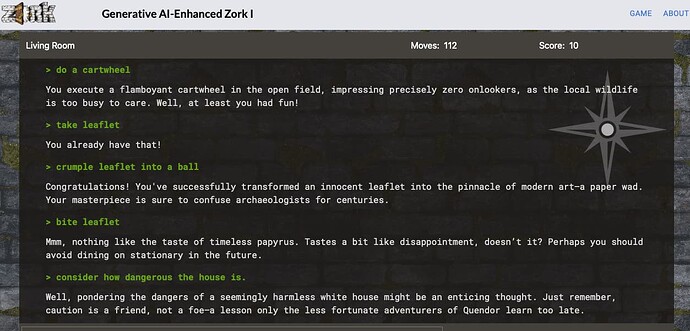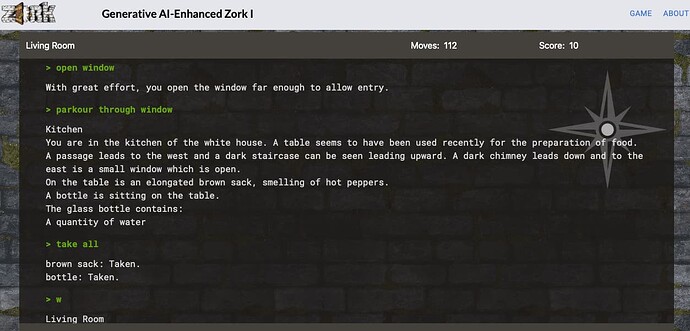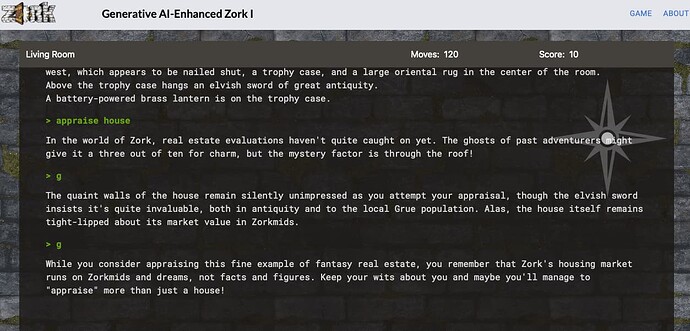I’ve found this paper where the author, Alexey Thikonov, propose a reinterpretation of the classic game Zork usin AI, “a system that combines the strengths of both classic and modern approaches. It transforms the classic game Zork (Blank et al., 1979) into smoother narration with a controllable literary style while preserving the original plot and game logic”.
There was a discussion on this i think.
Anyhow;
we propose a system that combines the strengths of both classic and modern approaches.
Did the author get it working?
Tangentially, Roberta Williams reimagined Colossal Cave as a first person graphical adventure.
Interview; she has major IF cred:
Having just read the linked paper, it basically says “we propose doing this”. No indication of how extensively the author has looked into doing this in practice (although they appear to be an academic working in this area, so I assume it’s intended as an ongoing research project rather than just a pie-in-the-sky idea).
There are some screenshots in the paper, and a demo video I found by googling, so I’m guessing there is a version up and running?
(The modified prose and optional pictures are the typical slop; the command translation stuff I suppose could have some use).
Ugh.
A lot of badly written purple prose doesn’t improve Zork, it makes it decidedly worse. The random and disconnected artwork pushes it off a cliff of horribleness.
There is a small mailbox here. ”
X MAILBOX
In the heart of a serene and lush forest, an unexpected sight breaks the natural harmony. A pristine white mailbox stands alone, its porcelain surface gleaming under the filtered sunlight. Surrounded by towering trees, their leaves forming a protective canopy above, the mailbox seems out of place yet strangely intriguing. Moss-covered rocks and fallen branches serve as nature’s carpet, contrasting against the starkness of the sanitary fixture. This peculiar scene evokes a sense of isolation and solitude, as if the mailbox has become a symbol of human intrusion into the untouched beauty of the wilderness. The forest’s peaceful ambiance juxtaposes with the utilitarian purpose of the mailbox, creating a visual paradox that prompts contemplation. What stories lie behind this incongruous encounter? Was it deliberately placed here or a forgotten relic of civilization? The silence of the forest amplifies the mystery, inviting the viewer to ponder the fragile BLAH BLAH BLAH SNORE SHOOT ME
-Wade
I found this. It appears to be something different than the one in the video. On the plus side: The text was terse and much the same as the original. It was surprisingly resilient to my attempts at destroying things, altering the world, or escaping the confines of the game. As for the negative: Things that should work, don’t. For example: Picking up the sword and lamp at the same time, or turning on/off the lamp (light/extinguish lamp works), and trying to restart by typing it, as opposed to using the menu in the corner, results in it trying to restore a save instead.
Overall I’d rate this far better than what’s in that video.
Edit: I suspect it is using the game itself as input to keep things from going off the rails, as the consistency of the game’s world model is too precise to be otherwise, in my opinion. The AI portion is just enhancing the occasional response or failure message I think.
That’s the thing about ChatGPT and other AI/LLM devices: Their output when asked a question or to improvise a description tends to go either “1000-word book report” on one end or “purple” on the other. AI does not yet seem to understand the concepts of “concise” writing or “less is more” and “brevity is the soul of wit” in the way authors can. It’s mimicking classical literature prose structures to describe mundane items like a dinner fork with the same expansiveness a human author would use for Tara in Gone With the Wind.
One of the things we’ve previously discussed about AI that causes problems in any persistent game world is AI seems to purposely have a short-term memory issue - it doesn’t have the capacity to remember past a couple exchanges what it’s said before, considering only what it’s immediately presented with, and this leads to the phenomenon that the AI sometimes seems to be ‘lying’ to you when it will sometimes deny things it stated as fact 8-10 exchanges before.
The place for AI (IMHO) in interactive fiction is as an “improviser” to fill in cracks in NPC dialogue and knowledge. The AI doesn’t actually maintain the world state, but it can look at it to understand that the last time Bob was in the same location as the golf trophy was when the player removed it from the trophy case so it can resolve dialogue like BOB, TELL ME ABOUT THE GOLF TROPHY with something subjectively logical like “I don’t know where it is now. It was in the trophy case, but I saw you take it upstairs a while ago,” instead of “There is no such thing here.”
The Zork that Mike brought up also has the flaw of mentioning things that don’t work, even in the error messages. For instance, I went full Eat Me and tried to EAT HAND, and the AI responded that hands aren’t on the menu, and that maybe I’d have better luck with the mailbox. In a human-generated game this would be a hint, but not here. EAT MAILBOX resulted in another error message, saying that the only thing worth tasting is the taste of adventure in the air. EAT ADVENTURE did work though, interestingly enough, and I did taste the adventure in the air.
Reading this, I was instantly reminded of The Wind in the Willows, for some reason. ![]()
Hi Mike. I’m the creator of https://newzork.ai, and I’m thrilled to have your feedback. Your hunch is correct - if your input affects the game in a way that would be expected in the original game, then the response is (deliberately) the same as the original game (though I do not use the original game or source code). My goal was to preserve as much of the original story as possible. The AI kicks in when you try to do something that would alter the story in an unexpected way. There are still some known issues (I have my own list of the about 50!) but I think the save/restore issue and the lantern issues have been fixed since your comment in November. I released version 1.0 last night, and it should be fully playable from beginning to end. Thanks again for your comment, and I’d love to answer any other questions you have.
I have to say I am actually impressed by this. Other than the usual ‘AI processing…’ lag before it responds, the AI actually does seem to be supplementing the parser with some unique and appropriate “parser-snark” sounding responses to silly commands without inventing plot randomly. It also seems to figure out whether unique actions might actually be appropriate. I was shocked when PARKOUR THROUGH WINDOW worked and LISTEN FOR HOUSE OCCUPANTS actually gave a legit response. This feels like a step toward “you can actually type anything”.
REARRANGE FURNITURE is such a troll command, but the AI actually manages to handle it and direct me to important objects.
Repeated commands don’t give the same response!
search the mailbox
You want to search the mailbox? Maybe you’ll find a Zorkmid hidden amongst the junk mail. Just kidding! There’s nothing interesting in there, so let’s move on before the mailman catches us snooping.
open it
Opening the small mailbox reveals a leaflet.
Thank you so much for the kind words!
Technically the leaflet is credits so it’s GUE junk mail and could be classified as not interesting! ![]()
Is there a way to transcript?
Indeed, this is the first example I’ve seen where adding LLM to a parser game does not seem to obviously make it worse. The “You can’t walk that way” variations quickly become annoying, though.
Another little glitch. Original Infocom Zork I:
> walk around the house
North of House
You are facing the north side of a white house. There is no door here, and all the windows are boarded up. To the north a narrow path winds through the trees.
ReZork:
> walk around the house
You decide to take a scenic stroll around the white house, basking in the fresh fantasy air of Zork. Remember, there’s more than just board games in this Great Underground Empire!
I like this description of the problem, but I think it’s overgeneralizing the consumer experience of ChatGPT to all LLM systems. Even with current-generation tech and no fine-tuning, a good base model and good prompting (ideally with a few writing samples in the desired style) can dramatically improve prose quality.
I think it is very well done, although I admit to not playing very far. Definitely the best use of AI in a text game I’ve seen. It is sometimes a bit more verbose than I’d like, but maybe that’s just me. I would like to test it out some more and see how well it handles some of Zork’s more obscure quirks, but not sure when I’ll have the time. Kudos on a good job.





